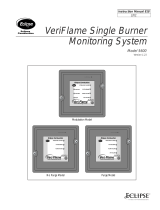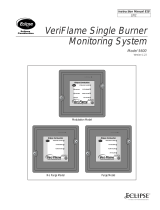Page is loading ...

FLAME MONITORING SYSTEM
WORLD LEADER IN FLAME MONITORING
MODEL 600 ULTRA FLAME ROD
APPLICATION MANUAL

GENERAL DESCRIPTION
The IRIS Model 600 Ultra Flame Rod is a reliable flame
monitoring system based on the proven principle of mea-
suring rectified current flow through a flame rod when
a flame touches it.
An AC voltage of 175 VAC is applied to the flame rod;
when a flame touches the rod, a rectified current flows
from the rod through the flame to the ground of the
burner. The Model 600 Ultra controller measures the
rectified current and closes the flame relay if the cur-
rent exceeds the value for the flame-on setpoint.
If the current flow drops below the value for the flame-
off setpoint, the flame relay opens. A visual display in-
dicates whether or not the flame relay is on and the
relative signal strength, i.e., the DC current flow through
the flame.
The Model 600 Ultra is also capable of driving either
(a) an ignition coil or (b) an ignition transformer.
(a) The ignition coil would be part of an ignitor assem-
bly; when using the ignition coil, the flame rod which is
used for sensing flame serves also as an ignition rod.
(b) AC power to an external ignition transformer is
switched on by a power relay in the Model 600 Ultra
controller when an ignition signal is applied. In this case,
the high voltage from the ignition transformer cannot
be applied to the flame rod; a separate ignition rod spaced
well away from the flame rod is required.
An AC or DC signal is applied to the Model 600 Ultra
controller to turn on the ignition coil and the ignition
transformer. When the signal is applied, the Model 600
Ultra controller pulses the ignition coil at 50 or 60 times
per second, depending on the line frequency. The igni-
tion signal also causes a power relay in the controller to
close, connecting the controller’s AC input voltage (af-
ter fuses) to an external ignition transformer if one is
hooked up. While the ignition signal is applied, the flame
relay is held open.
The sensitivity of the Model 600 Ultra to flame can be
changed by means of a jumper. Four sensitivity levels
are provided. The sensitivity of the display and the val-
ues of the flame-on and flame-off setpoints are all
changed together by the jumper.
Various protection features are provided. The flame
rod itself can be shorted to ground indefinitely without
harm to the unit. If the flame rod becomes fouled so
that an unreasonably large amount of AC current flows
from the flame to ground, first a yellow “ROD
FOULED” LED is turned on. If the AC current in-
creases further a “ROD FAULT” LED is turned on
and the flame relay is opened. Note that the Model 600
Ultra controller distinguishes between AC current flow
due to fouling and DC current flow caused by the pres-
ence of a flame.
If a person who is grounded happens to touch the flame
rod, a perceptible shock will be experienced. This is not
considered to be dangerous, since less than .5mA of
AC current will flow. If the flame rod is also used as an
ignition rod, and the rod is pulsed by an ignition coil, the
shock will be more intense. Because of the short dura-
tion of the pulses, this is not considered to be danger-
ous. As with all electrical equipment, power should be
removed before servicing.
MODEL 600 ULTRA CONTROLLER
INSTALLATION
The Model 600 Ultra Flame Rod controller mounts on a
35 mm DIN rail. See Figure 1. The DIN rail release is
at the top of the unit.
See Figure 2. Five Phoenix plugs are provided with the
controller, P1 through P5. AC power is connected to
pins AC L1 and AC L2 of P5. Set P4 for 115 VAC or
230 VAC depending on the line voltage. The voltage
does not have to be extremely close to 115 VAC or 230
VAC; the controller is quite tolerant accepting 85 VAC
to 132 VAC or 170 VAC to 264 VAC. However, the
flame signal strength will be affected somewhat with
AC voltage changes. This should not be a problem be-
cause flame rods have excellent discrimination between
flame on and flame off.
The controller will operate equally well on 50 Hz or 60
Hz power.
It is very important to connect the GND input on the
controller to the ground of the burner. It is assumed that
the third wire AC ground is at roughly the same poten-
tial as the burner ground, so connection of GND to the
AC line ground should be satisfactory. If the GND
input is left open, flame will not be detected.
The ignition command is applied at pins IGN AC, IGN
COM, and IGN DC. A DC ignition command from 12
VDC to 50 VDC is applied between IGN DC and
IGN COM; it can be either positive or negative in po-
larity. An AC ignition command from 85 VAC to 264
VAC (50 or 60 Hz) is applied between pins IGN AC
and IGN COM.

The Model 600 Ultra will operate equally well in sev-
eral configurations: flame rod only, flame rod with igni-
tion coil, and flame rod with ignition transformer. (It will
also operate with both an ignition coil and an ignition
transformer.)
The wiring for the flame rod only is shown in Figure 2;
it connects to the ROD/COIL pin on the controller.
If the ignition command is applied without the ignition
coil present, the voltage to the flame rod is not affected.
The pulsing of the ignition coil is done from the COIL
TAP pin of the controller.
The wiring of the ignition coil is shown in Figure 2. Pin
C for the coil is usually connected to ground in the igni-
tor assembly; this ground connection is not necessary
for coil operation. The flame rod operates through the
ignition coil when the ignition coil is not being pulsed.
When an ignition command is present, with every pulse
to the coil a strong spark is emitted from the coil tip
through the flame rod to ground. The pulse rate will be
the same as the line frequency, 50 or 60 pulses per
second. The air gap between the flame rod and ground
should be 2 to 3 mm. The nominal arc voltage is 7,000V.
If the gap is very large, there will be no arc when the
coil is pulsed. Such pulsing will not be damaging to the
coil. The peak voltage at the coil tip when no arc re-
sults will not exceed 11,000V.
When the ignition command is applied the AC power to
an ignition transformer is turned on by a DPST relay.
See Figure 2. The controller is normally shipped with
two .5 A fuses installed. If an ignition transformer is to be
used, the two 5 A fuses supplied in a small bag with the
controller must be installed in the controller. Remove the
three black screws on each side of the controller, lift off
the top assembly, unplug the two .5 A fuses, plug in the
two 5 A fuses, and reassemble the controller.
FRONT PANEL FUNCTIONS AND SETUP
Six numeric LED digits arranged vertically provide a
graphic visual display of the flame signal. If the Flame
Rod is connected and the AC power is on (green
POWER LED will be on) and there is no flame signal,
none of the numeric digits will be on. With a weak
flame signal, either the “1” or “2” digits will be on but
the Flame Relay will be off. A stronger signal will be
indicated by “3” or a higher digit turning on; with this
stronger signal the Flame Relay will be turned on.
In normal operation when the flame is present the “5”
or “6” digits should be on with, perhaps, digit “4” turn-
ing on occasionally.
If the “3” or “4” digits are on most of the time, the gain
should be increased by moving P2 to a higher gain posi-
tion. If the “6” digit is on steadily, the gain is probably
set too high; move the P2 plug to a lower gain position.
If the LED for ROD FOULED is on, the Model 600
controller will continue to operate, but this is a warning
that a small amount of AC current is flowing from the
flame rod to ground. This means that the flame rod or
its mount probably needs cleaning.
If the fouling gets to be significant, approaching the point
where the flame signal could be affected, the LED for
ROD FAULT will turn on, causing the flame relay to
open. This fault condition will be removed as soon as
the fouling is sufficiently reduced.
CONTACT INFORMATION
For further information contact:
Sales and Applications:
IRIS SYSTEMS INC.
7583 Vantage Place
Delta, BC, Canada V4G 1A5
Ph. 800-667-IRIS, FAX 604-581-9790
email: [email protected]
Manufacturing and Service:
IRIS SYSTEMS INC. (JB Systems, Inc.)
4944 - 113th Avenue North
Clearwater, FL 33760
Ph. 727-545-3900, FAX 727-547-9589

2.98"
3.25"
5.49"
.28"
35mm DIN RAIL
DIN RAIL RELEASE
C
L
FIGURE 1 - MODEL 600 ULTRA FLAME ROD CONTROLLER
ROD
POWER
FAULT
FLAME ROD
GOOD
SIG A
ROD
ROD
FOULED
GAIN 1
GAIN 2
NO JMPR = MAX GAIN 4
SIGNAL
Relay On
WEAK
SIGNAL
Relay On
POOR
SIGNAL
Relay Off
MODEL 600 ULTRA
GND
115 VAC 50/60 HZ
230 VAC 50/60 HZ
SIG B
ROD
XFMR
XFMR
AC
IGN
COM
IGN
DC
IGN
RF A
RF A
RF A
RF B
GAIN 3
RF B RF B
TURN IGN ON
TO XFMR
LINE INPUT
SELECT FOR LINE INPUT
P1 P2 P3
P4 P5

ROD
FAULT
FLAME ROD
GOOD
TAP
COIL
ROD
FOULED
GAIN 1
GAIN 2
NO JMPR = MAX GAIN 4
SIGNAL
Relay On
WEAK
SIGNAL
Relay On
POOR
SIGNAL
Relay Off
MODEL 600 ULTRA
GND
115 VAC 50/60 HZ
230 VAC 50/60 HZ
COIL
ROD/
XFMR
XFMR
AC
IGN
COM
IGN
DC
IGN
RF A
RF A
RF A
RF B
GAIN 3
RF B
RF B
TURN IGN ON
TO XFMR LINE INPUT
SELECT FOR LINE INPUT
ROD
FLAME
ROD
IGNITION/FLAME
IGNITION
COIL
GAIN 1
GAIN 2
NO JMPR = MAX GAIN 4
GAIN 3
.5A
OR
5A
.5A
OR
5A
FLAME ROD ONLY
AC IN
GND
TO IGN XFMR
TAP
COIL
COIL
ROD/
P1
P2
P3
P4
P5
GND
CBA
COIL TIP
GND
GND
230 VAC POSITION
115 VAC POSITION
FIGURE 2 - WIRING FOR MODEL 600 FLAME ROD ULTRA

SPECIFICATIONS FOR MODEL 600 ULTRA FLAME ROD
ELECTRICAL
Primary Input Power – 85 to 132 VAC, or 170 to 264 VAC, 50 or 60 Hz
Input Current, Monitoring only – .07 A at 115VAC, .035 A at 230 VAC
Input Current, Ignition on – .3 A at 115VAC, .15 A at 230 VAC
plus current to ignition transformer (5 AMPS MAX.)
Ignition Command Input – 12 to 50 VDC or 85 to 264 VAC, 50 or 60 Hz
(using labeled DC and AC inputs)
Command Current – .02 A DC at 50 VDC, .015 A RMS at 230 VAC
Maximum Capacitance Load – 1.0 nF, flame rod drive to ground (through wire insulation)
OUTPUTS
Flame Relay – DPDT contacts, rated 5A at 125 VAC, 277 VAC, and
30 VDC
Ignition Transformer Relay – DPST contacts, rated 5A at 125 VAC and 250 VAC
Ignition Coil Drive – A capacitance of 4.4 uF is discharged from 230 VDC
through the ignition coil tap at the AC line rate by a
4A, 400 V SCR
ENVIRONMENTAL
Ambient Temperature – Controller 0°C to 60°C (32°F to 140°F)
SAFETY
Flame rod voltage – 175 VAC at 115/230 VAC input
Flame rod current (not firing) – Maximum current to ground <0.5ma
Rev: 0905
/

